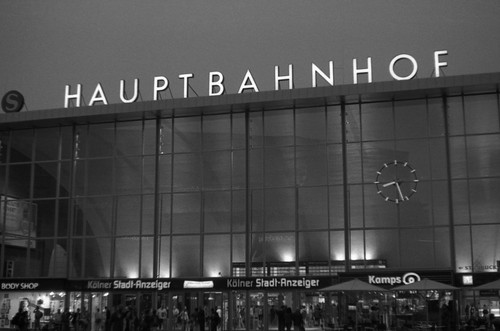During the summer after my A-levels, I spent most of my time either reading or drawing. Early summer had been hot and sunny, but July turned rainy, and, having studied Howards End, I read all of Forster's other novels, a couple of them in a day, and his short stories (other readings were Conrad's short stories in their hardback Everyman editions, and a large volume of Edgar Allan Poe). In Howards End, published in 1910, Forster's perspective on Germany feeds into a history for the Schlegels: their father left the Germany he loved through seeing it becoming distorted as a result of Bismarck's unification: "It was his hope that the clouds of materialism obscuring the Fatherland would part in time, and the mild intellectual light re-emerge".
Looking at Baedekers from the period before the First World War, when Forster wrote all his novels except A Passage To India, among the books' notable approaches is the way that they are laid out: they are written in routes. Prior to air travel fundamentally changing an appreciation of physical space, travel could not escape contiguity: the only way to reach a destination was by moving through the landscape from one's point of origin. Therefore, a guidebook to one particular place - even though this might be the destination - made less sense in a world confined to surface travel in a linear fashion. Travellers would naturally have an interest in negotiating the spaces and modes of transport in between, and before faster trains, reaching cities in the continent from England would entail several days' duration, so places to stay at nodal points along these linear routes were also of interest. Thus, tracing the routes in Baedeker's The Rhine and Northern Germany (1870), my journey to Wuppertal encompasses:
[Route] 1. From Brussels to Cologne.
By Express in 6 1/2 hrs.; fares 27 fr. 75, 20 fr. 50 c. Custom-house formalities at Cologne (or at Aix-la-Chapelle , if the traveller proceeds no farther). Finest views between Louvain and Liège to the right. District between Liège and Aix-la-Chapelle replete with interest.
[Then Route 42 from Cologne to Düsseldorf.]
[Route] 47. From Düsseldorf to Cassel.
Express in 8 3/4, ordinary trains in 13 hrs.; fares 7 Thlr. 25, 5 Thlr. 18, 3 Thlr. 25 Sgr. District as far as Dortmund and beyond Paderborn picturesque and industrial; structure of the line itself an object of interest. From the convent of Gerresheim (first stat[ion]., fine church of the 12th cent.), Archbishop Gebhard of Cologne abducted the beautiful Countess Agnes of Mansfeld. After passing Erkrath (hydropathic estab.), the train ascends to Hochdahl (large iron-foundry of Eintracht), 494 ft. higher than Düsseldorf.
[...]
Vohwinkel (see above) is a junction of the Prince William line (Steele-Vohwinkel), principally used for the coal traffic.
From Vohwinkel to Steele in 1/4 hr.; fares 27, 20, 13 Sgr. —
Beyond stat[ion]. Aprath the line crrosses the watershed between the Wupper and the Ruhr, and then follows the valley of the Deile. Stat[ion]. Neriges, a resort of pilgrims, with an old chateau; stat[ion]. Langenberg possesses several thriving silk factories. At stat[ion]. Kupferdreh the Ruhrthal is suddenly entered, presenting a striking and picturesque contrast to the narrow sinuosities of the Deilethal. Numerous coal-mines are passed. Where the train crosses the Ruhr, a pleasing glimpse of the valley is obtained.
[...]Elberfeld and Barmen, already physically joined at this date, would become Wuppertal ("Wupper-Valley") in a referendum of 1930. I haven't calculated how long the whole journey would have taken, but in 1870, Brussels to Cologne - by express - took six and a half hours. My train was 1 hour and 47 minutes. Wuppertal's principal 'manufacture' is now pharmaceuticals: the giant Bayer factory spreads the distance of a few stops of the Schwebebahn.
At Sonnborn the train suddenly enters the valley of the Wupper, traverses it, then skirts the hill-side, commanding a view of Elberfeld below.
Elberfeld [...], pop. 65,321 (12,000 Rom. Cath.), and the adjoining town of Barmen [...], with 64,945 inhab., together form a series of streets nearly 6m. in length, intersected by the road, railway, and the Wupper, which is the principal source of the industry of this district. With the exception of some English towns, there is probably no spot in the world so densely populated. Its principal manufactures are cotton, silk, ribbon, and turkey-red dyed goods. Some of the churches and public edifices are handsome, but, like the towns themselves, of very modern date.
Forster's characters embody differing perspectives on the ubiquitous Baedeker. In Where Angels Fear To Tread it is seen as an essential source of information, as it is also seen by Lucy in A Room With A View: “Taking up Baedeker's Handbook to Northern Italy, she committed to memory the most important dates of Florentine History. For she was determined to enjoy herself on the morrow”; meanwhile Eleanor Lavish, the novelist, is dismissive: "I hope we shall soon emancipate you from Baedeker. He does but touch the surface of things. As to the true Italy—he does not even dream of it. The true Italy is only to be found by patient observation." and:
"Lucy, who wanted to see Santa Croce, suggested, as a possible solution, that they should ask the way there. 'Oh, but that is the word of a craven! And no, you are not, not, NOT to look at your Baedeker. Give it to me; I shan't let you carry it. We will simply drift.'"Eleanor Lavish, who, by drifting, in this scene effects another meeting between Lucy and the Emersons, is a Situationist avant le lettre.
E. M. Forster, A Room with a View











